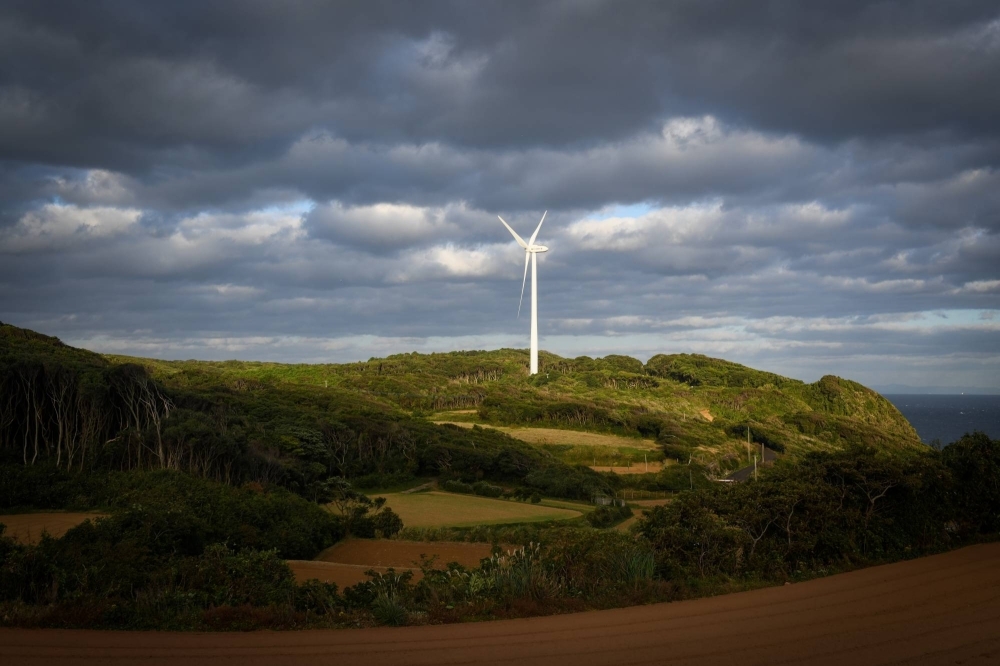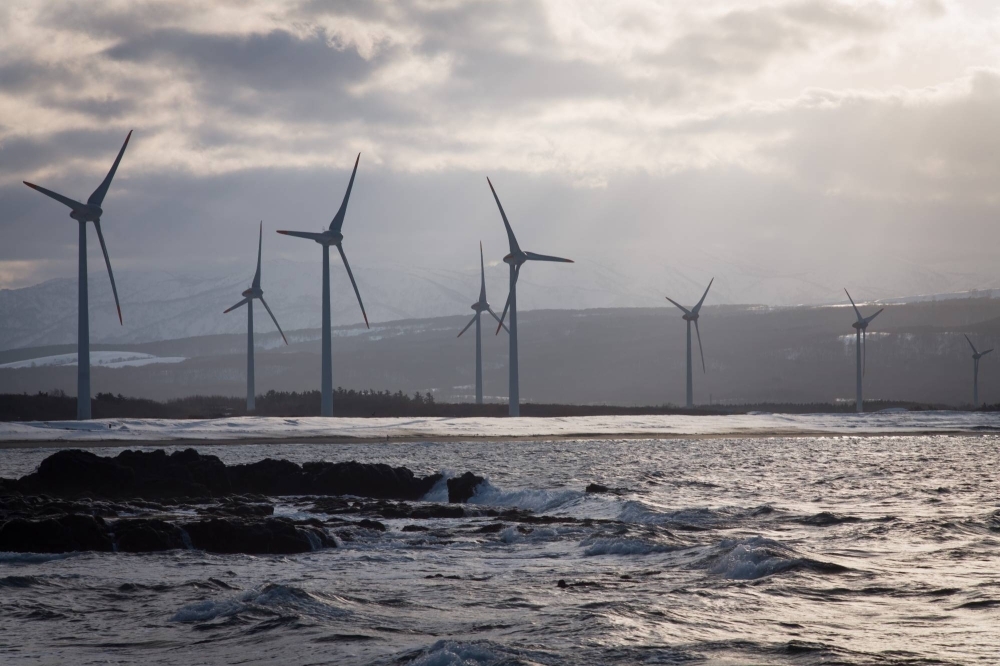One would only need to look at a map to understand the potential offshore wind has for a country like Japan. Now, the government is eyeing moves to truly harness it.
Time may have run out in the just-completed session of parliament for a new legislative amendment that promised to provide a major boost for Japan’s sputtering wind industry by opening up vast amounts of marine territory for offshore turbines, but the bill’s next chance at passage could come as soon as this fall.
That would be no small matter, with wind power advocates saying that the amendment could spur development of an industry that many believe is Japan’s best chance at achieving carbon neutrality by 2050.
Currently, Japan isn’t close to being on track to meet its ambitious 2050 goal, or its fiscal 2030 target of a 46% greenhouse gas reduction from 2013 levels. Fossil fuels still consist of 69% of the nation’s power mix, with renewables making up just 24%, putting it far behind many European countries.
Slow policymaking and opposition from big power companies have helped delay the transition to renewables.
“Large companies continue to reject renewable energy, even when they are efficient,” says Hiroshi Ohta, a researcher working on climate politics and policy at Waseda University. As one example, he refers to Kyushu Electric disconnecting from independent solar producers. “No politicians try to break down (the current) system.”
In fact, an extreme reliance on imported oil and gas have led Third Generation Environmentalism (E3G), a climate change think tank, to rate Japan’s energy mix 25 out of 120, the lowest in the Group of Seven.
And while the global offshore wind industry has in recent years suffered from a crowded market and supply chain disruptions due to COVID-19, in Japan, the technology has only just begun to raise its sails — with this bill expected to be just the boost the industry needs.
Vast seas, vaster supply of wind
The construction of offshore wind farms have ramped up around the world over the last decade. The global industry saw new capacity grow by 24% year on year in 2023, and the energy source has been growing at record rates in Europe and China in recent years.
Offshore wind turbines come in a variety of types, ranging from less expensive models fixed to the seafloor in shallower waters, to varieties that can float. They are typically connected to the grid via electrical cables buried below the seabed.
The potential for mass installation and strong energy efficiency are offshore wind’s top benefits. Wind conditions are better at sea, and few obstacles on the water allow for rapid and large-scale construction. The intensive manufacturing process required to build the turbines also creates jobs and drives industry.
A hurdle, however, is the high installation and maintenance costs. Japan still has relatively little infrastructure for the manufacturing and installation of turbines, keeping these costs high.
There are also some environmental concerns: Although research shows that most flocks of birds avoid wind farms and marine mammals return to sites after construction has finished, the construction process could have negative effects on avian and marine life.
The fishing industry has also tended to voice concerns about the impacts of offshore wind power, but in fact, turbine pillars can serve as artificial reefs, and examples from around the world show that offshore wind attracts fish and can coexist with fishers.
Overall, the enormous benefits amid the need for an unprecedented energy transition have made offshore wind an appealing option for many nations — and that might be doubly true for resource-poor Japan.
According to the International Energy Agency, Japan could produce over 900% of its energy demand with offshore wind alone. This is possible due to Japan’s massive exclusive economic zone, which covers 4.5 million square kilometers, or about 12 times the size of its landmass, creating an essentially endless supply of wind, and water on which to build turbines. And with that potential in mind, the wind power bill would open up the nation’s sizable EEZ to wind power projects.
Tetsuo Saito, senior researcher at the Renewable Energy Institute, explains that Japan’s 2023 offshore and semioffshore wind capacity was just 0.03% of its potential.
“The government is making all the right progress toward expanding offshore wind, but the speed is slow, and the scale is small,” says Saito. “We should increase the number of projects.”
An REI report authored by Saito shows that Japan has bountiful high-speed wind areas, particularly around the northern and southern tip of Hokkaido as well as Kyushu’s Sea of Japan coast, where waters feature average wind speeds over 7.5 and up to 10 meters per second, allowing for efficient energy production.
Some of the biggest offshore wind projects in Japan to date have been implemented in Hokkaido and the Tohoku region. These include the recent 13-turbine, 140-megawatt Noshiro and Akita Port project in Akita Prefecture and the eight-turbine, 112-MW Ishikari Bay farm near Sapporo. The developments started supplying Tohoku Denryoku and Hokkaido Denryoku in January of 2023 and 2024, respectively.
Yamagata Prefecture, which also sees favorable wind conditions on its Sea of Japan coastline, currently has multiple offshore wind projects in development. Junichi Sugiyama, from Yamagata’s Energy Policy Promotion Division, says the biggest hurdle is negotiating permission with the local municipalities and fishing industry.
“We obtained consent for one of the sites (in Yuza), but we’re still discussing with the local bodies for the other (in Sakata), where there are more parties involved,” explains Sugiyama. “Some fishermen are demonstrating their opposition, so we are trying to explain to them that fisheries and wind power can coexist.”
Opening up new territory
The proposed law has essentially two clauses.
First, it establishes a system to permit businesses to install offshore wind facilities in the EEZ. This allows the Ministry of Economy, Trade and Industry to choose areas to solicit offshore wind development. Then METI and the land ministry will issue preliminary approval for operators, create a council of relevant stakeholders and grant final permission based on the agreement of the council.
Second, the bill allows for research on the marine environment in EEZ waters in order to designate specific “promotion zones.” Currently, operators have to build within Japan’s territorial waters, which are managed by prefectural governments. By contrast, the national government controls the EEZ.

Time may have run out in the just-completed session of parliament for a new legislative amendment that promised to provide a major boost for Japan’s sputtering wind industry, but its next chance at passage could come as soon as this fall.
| Bloomberg
Takahiro Ishii, director at METI’s Wind Energy Policy Office, says that the agency only began to consider this initiative in the last two years in order to help meet their published goal of 30 to 45 gigawatts of offshore wind power capacity by 2040. “It is going to be difficult to meet our objectives just within the territorial waters, without expanding to the EEZ,” he says.
Saito agrees, saying that “The opportunities expand drastically outside of the territorial waters.”
“However, since the national government gives permission for activities in the EEZ, it’s difficult to negotiate permission with parties such as fishermen that could be affected by construction,” he explains.
That’s because when building in prefectural waters, the local government has unhindered access to all affected parties. But outside the territorial waters, sea usage is often not well understood, leading to additional complications when obtaining permissions. Still, the bill is expected to help simplify and streamline the process to build more wind power capacity.
In addition, the border of Japan’s territorial waters is relatively close to the shore, so building offshore wind in the EEZ is likely to be more costly due to greater water depth and distance from the coast. Nonetheless, the REI’s analysis shows that a substantial amount of Japan’s most abundant wind resources lie in the EEZ, especially around Kyushu and Hokkaido.
Japan also isn’t ready for a rapid-fire rollout.
“There is still a lot of work to be done to unleash this full potential,” says Yoko Mulholland, senior associate at E3G. “To give a few examples, it would be crucial to shorten lead times and (clarify) technical standards, and integrate operation (into) electricity networks on a national scale.”
The necessary power transmission lines will need to be constructed to accommodate large-scale offshore development, especially in Hokkaido and Tohoku.

A fisherman on board a snow crab vessel in the sea west of the Noto Peninsula in November 2021. The fishing industry has tended to voice concerns about the impacts of offshore wind power, but examples from around the world show that offshore wind can coexist with fishers.
| Bloomberg
The proposed law also leads to some gray areas for offshore wind development already in progress.
Previously, individual business operators conducted the assessment in areas being considered for development, but with the amendment, that responsibility would be shifted over to the national government — putting a project like Yamagata’s prospective Sakata offshore development in an unusual position. Since the project is already in its secondary stage, “it’s unclear whether or not the amendment will apply to the Sakata project,” says Sugiyama.
Despite these uncertainties, Walter James, lead consultant at Power Japan Consulting, writes that the legislation would bring “a number of indirect but no less important benefits,” boosting manufacturing sectors, deterring illegal fishing activities and bringing development to regional communities facing population decline.
Despite passing in the Lower House on May 28, the bill was not passed by the Upper House before the regular parliamentary session ended, delaying its implementation by several months.
“Next, the government should create a roadmap for the large-scale rollout of offshore development projects,” Saito says.
Ishii also emphasizes the need for coordination and knowledge-sharing with like-minded countries to find ways to lower rollout costs, promote mass production and advance solutions such as floating technology for deeper waters. One example within Japan is the Floating Offshore Wind Technology Research Association, which was established by power companies this March.

A wind turbine by the shore in Iki, Nagasaki Prefecture
| Bloomberg
There is a strong financial incentive for the government to put in the necessary work. In Europe, where offshore wind has become mainstream, the cost dropped by 55% from 2011 to 2021, largely due to increased efficiencies as the technology scaled. Once Japan increases its offshore wind capacity, the power source can become an economically tempting offer to go along with its environmental benefits.
In 2022, the cost of 1 megawatt hour generated by coal and natural gas in Japan was $83 and $40, respectively, while offshore wind was priced at $105 per megawatt hour. But if the same trend seen in Europe tracks, offshore wind will quickly become competitive.
“We import so many fossil fuels in Japan,” says Saito. “But we don’t need to import renewables. Once the cost decreases, they will inevitably become attractive.”
Saito adds that Japan is fortunate because it has a reliable climate for renewable energy: High- and low-pressure weather systems typically dictate that when it’s cloudy and windy in Kyushu for wind power, it’s sunny in Hokkaido for solar power, and vice versa.
“Looking all the way from the southern to northern tip, the wind is always strong somewhere in Japan,” he says. “There’s a way to raise our renewable energy makeup to 80% or 90% — it’s not just a dream.”
https://www.japantimes.co.jp/environment/2024/06/30/energy/offshore-wind-eez-bill/”>
#Japan #sea #overdue #wind #power #boost

